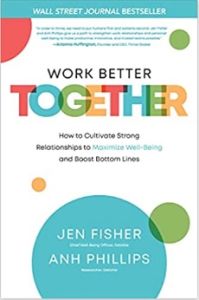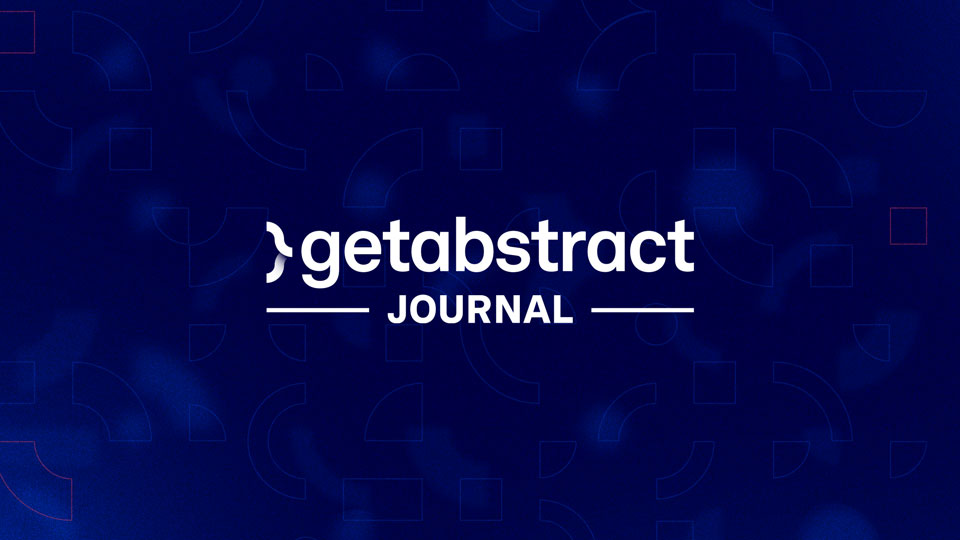Join getAbstract to access the summary!

Join getAbstract to access the summary!
Jen Fisher and Anh Phillips
Work Better Together
How to Cultivate Strong Relationships to Maximize Well-Being and Boost Bottom Lines
McGraw-Hill, 2021
What's inside?
A supportive work environment helps you feel good about yourself, your job and your output.
Recommendation
Human connection is essential to workplace success. Genuine, trust-based work relationships increase job satisfaction and enable employees to perform at their highest level. Deloitte chief well-being officer Jen Fisher and researcher Anh Phillips lay out a strong business case for fostering workplace relationships, prioritizing self-care, becoming intentional about technology usage and consciously building well-being into your work processes.
Take-Aways
- Authentic connection and meaningful workplace relationships nourish psychological well-being.
- Relentless striving to increase productivity and incorporate new technologies creates less humane work environments.
- Increase social bonds to combat the negative effects of technological dependency.
- Understand your work style, and that of your team members, to enhance collaboration.
- Emphasize well-being and healthy relationships to create strong team dynamics.
- Psychological safety, empathy and trust constitute the foundational pillars of a healthy team.
- Outdated and toxic ideas about overwork contribute to unhealthy workplaces.
- Create a personalized well-being plan to manage career pressures.
- Technology can’t replace the importance of people skills.
- Set clear boundaries around your use of technology.
Summary
Authentic connection and meaningful workplace relationships nourish psychological well-being.
Loneliness is endemic in the United States, and over 40% of Americans feel lonely, even when surrounded by co-workers. Only 20% forge meaningful workplace friendships; the rest suffer disconnection, disengagement and dissatisfaction. Loneliness increases susceptibility to cognitive decline and physical ailments. The increase in remote and gig work exacerbates this problem by reducing in-person interactions; burnout is on the rise. Workplace relationships prove essential for feeling valued and cared for.
Relentless striving to increase productivity and incorporate new technologies creates less humane work environments.
The overuse of technology undermines its central purpose: to make work easier and more productive. Being digitally connected 24/7 and deluged with information and communication, paradoxically, increases alienation. “Workism,” the lifestyle of being always on and always working, isn’t sustainable long-term. Chronic overwork eventually decreases output and causes stress-related problems such as burnout, depression, heart disease and sleep disorders.
“The theme of doing more in less time is a quiet drumbeat underneath so many company cultures that we hardly notice it.”
Continually learning and adapting to modern technologies, coupled with the need to upskill, generates anxiety, fatigue, increased alcohol consumption and strained home relationships. The focus of businesses on increasing efficiency and productivity, and persistently introducing new technologies, can generate less humane work environments.
Increase social bonds to combat the negative effects of technological dependency.
Spending too much time in cyberspace depletes two of your most valuable resources: time and attention. The reduction in face-to-face interactions dehumanizes work environments and threatens the psychological safety people need to share ideas, be creative and take risks. Workism induces people to associate their value with busyness. Responding to the constant assault of digital communications lessens your ability to differentiate between important and unimportant tasks.
“The integration of technology into our work and personal lives has happened faster than almost any other disruption in human history.”
Two-thirds of employees suffer burnout. The costs to business are numerous, including employee disengagement, decreased performance and increased turnover. The antidote to this malaise is social connection; people who report work satisfaction have strong work relationships. They suffer less stress, enjoy better attendance, and are more engaged, productive and resilient.
Understand your work style, and that of your team members, to enhance collaboration.
Be cognizant of different work styles to get the most out of your team. Work style is a combination of character, values, skills and proficiencies. For example, Ethan’s team works well together in a company that provides high-tech solutions to manufacturers. Ethan has a collaborative work style and excels at bringing people together to resolve issues. Nichole is meticulous, an asset for meeting deadlines and staying on budget. Chloe, in interactive training, excels at big-picture thinking, while Josh’s strength lies in his technical proficiency.
“Understanding your tendencies and preferences helps you design a work life in which you are using your talents and skills at their best.”
“Business Chemistry” is an analytical tool for assessing work styles created by Deloitte that categorizes people into four personality types. “Pioneers,” like Chloe, are creative, big-picture thinkers. Nichole is a “Guardian”: Her strength lies in nailing down the details and conforming to processes. Josh, quantitative and analytical, is a “Driver”; diplomatic Ethan is an “Integrator.” No one, of course, fulfills only one role exclusively; everyone operates somewhere on a behavioral continuum depending on situation and temperament.
Emphasize well-being and healthy relationships to create strong team dynamics.
When people feel comfortable, connected, valued and valuable at work, business prospers. Connection, comfort and contribution promote feelings of belonging, and result from strong interpersonal relationships. Unfortunately, team leaders often value these qualities less than productivity and performance; this inhibits team performance.
“When a company relegates well-being and healthy relationships to its second tier of values, it’s like a sports team of talented players who don’t stay healthy and don’t learn to work together.”
Businesses that place a high premium on well-being and healthy relationships create the strongest, healthiest team dynamics. Workplaces that emphasize transactional, business-first relationships, on the other hand, foster a culture that thinks in terms of “winners” versus “losers.” Team members who work highly independently can miss out on opportunities to collaborate, pool resources or solicit help from each other. In the most unhealthy organizations that don’t value well-being or relationships at all, teams devolve into dysfunction, confusion, apathy and low performance.
Psychological safety, empathy and trust constitute the foundational pillars of a healthy team.
High-functioning teams outperform the competition, while being more cost-efficient, flexible and resilient. Team members share knowledge, have a keen sense of belonging, enjoy a positive outlook and share mutual trust, qualities that foster better problem-solving, creativity and innovation.
Your approach to building a healthy team will vary depending on the work style and temperament of its individual members. Identify structural barriers such as faulty workplace design, flawed communication logistics and operational silos. Assess cultural barriers such as workism, skewed reward systems and favoritism.
Psychological safety, empathy and trust form the foundational tenets of a strong team. Psychological safety empowers team members to work through conflicts and share ideas. Empathy helps employees identify and relate to each other’s feelings, motives and behaviors. Trust builds confidence that colleagues are honest, reliable, responsible and determined – people you can feel physically and emotionally safe around.
“Think of your team as a small, very talented jazz band that’s setting out to hit its goals with a bit of improvisation along the way.”
Create a “Ways of Working” guide – principles that steer team members’ progress while fostering their well-being. For example, a team might prioritize principles such as “be in beta,” to emphasize the need to work collaboratively. Team members should create a code of values to inform decision-making, such as, “well-being is priority #1” or “shared success equals individual success.”
Leaders must make well-being a strategic priority, support it with resources, communicate and advocate its benefits, and demonstrate a personal commitment by modeling healthy behaviors. When an organization clearly articulates its vision of well-being, employees understand what it entails and how their actions and behaviors contribute to it.
Outdated and toxic ideas about overwork contribute to unhealthy workplaces.
Impediments to workplace well-being include sexism, discrimination, unsafe conditions or unequal compensation. A workism mind-set perpetuates views that prevent self-care. Such negative views include the following:
- Well-being is only about physical health – In addition to mental and physical welfare, well-being includes feeling secure, accomplished and personally satisfied.
- Money determines success – Material wealth is not the only important measure of accomplishment.
- Only weaklings rest – Taking time to recharge and replenish boosts resilience and guards against burnout.
- Burnout is an unavoidable byproduct of success – The human cost of working long hours and high stress is severe; yet the idea that workism is necessary to attain wealth and power remains foundational in many competitive industries.
- Success means sacrificing your personal life – Loving your job shouldn’t mean sacrificing everything else in your life.
Create a personalized well-being plan to manage career pressures.
Constant time pressures, blurred lines between important and unimportant tasks, and an overblown sense of urgency create a scarcity mind-set that inhibits solid decision-making.Prioritizing daily tasks, reducing time spent in meetings, scheduling uninterrupted periods of work and taking frequent breaks prevent this mentality from ambushing your workday.
“Learning to be mindful, deliberate and realistic about work, and building in slack to your overall schedule, builds your capacity to thrive even through the most stressful times.”
Create a personalized well-being plan to counteract career pressures. Craft a personal definition of well-being and identify the activities that contribute to your ongoing health. For example, you feel better when your diet is healthier, you work out regularly, spend more time with your family and maintain a mindfulness practice. Set achievable goals to incorporate well-being activities into your daily routine: plan nutritious meals, schedule exercise or meditation, or limit screen time.
Technology can’t replace the importance of people skills.
Digitization is not a substitute for people skills – like creativity, empathy, adaptability and emotional intelligence – that fuel problem-solving and new product development. Even quantitative and analytical jobs require a combination of right and left-brain capabilities, or hybrid skills. As the proliferation of technology and pace of change accelerates, companies must foster healthy social systems that put people skills front and center. Robust teams prioritize healthy interactions that nurture resilience, flexibility and creativity.
“Developing your most human skills makes you a more effective player, more open to learning and more able to deal with the realities of today’s work: volatility, uncertainty, change and ambiguity.”
Merge your emotional intelligence and cognitive strengths to boost your value and productivity. Gain a clear understanding of your professional persona, that is, the behavioral attitude you manifest at work. Ensure it aligns with your genuine self to facilitate authentic interactions. Find out how others perceive you by asking for feedback and welcoming suggestions. As you bring your human skills to the forefront of every interaction, you contribute to a culture of well-being throughout the organization.
Set clear boundaries around your use of technology.
Social media can hijack your time and attention. It generates rewards at unpredictable intervals to keep you scrolling, clicking and viewing for longer periods. These incentives trigger emotional reactions; you smile at feel-good pictures, laugh at funny clips, or respond to offensive, enraging or distressing stories. Your brain responds with a chemical surge of dopamine, and like an addict, you seek another hit. Social media is designed to suck you in and keep you hooked.
“It’s the paradox of our work lives that our abundance of…information has made the most human gifts, like wisdom and empathy, scarce resources.”
To maintain your well-being, set boundaries and make intentional choices when using technology. Become aware of why, when and how you engage with it. Note compulsive desires to check your feed, phone or email; make deliberate, not reflexive, choices about how to use your time most productively. Undergo a digital detox to wean yourself from detrimental tech-related behaviors. For example, pick a day to stay off social media, ban smartphones from the dinner table, delete apps you rarely use, or schedule device-free time.
About the Authors
Jen Fisher is the chief well-being officer at Deloitte US and host of the podcast, WorkWell. Anh Phillips is co-author of The Technology Fallacy and a senior leader at Deloitte Consulting.
This document is restricted to personal use only.





























Comment on this summary